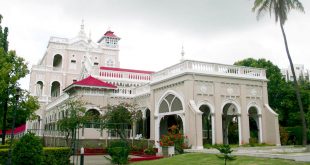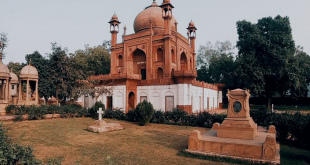Mahabharat has been one of the most popular mythological stories of India. Lakshagraha happens to be one of the chapters from the epic of Mahabharat.
Lakshagraha is referred to as a house that was built after getting orders from the eldest kaurava, Duryodhana, who was highly influenced by his maternal uncle, Shakuni. It was nothing but a plot made to kill their cousins, Pandavas along with their aunt, Kunti.
To construct the maze in the middle of the forest of Varnavrat, they had appointed the chief architect, Purochana. As per the plans the house had to be constructed from Lacquer, which happens to be a highly flammable material. The plan and the plot were kept highly confidential. The structure was made in such a manner that anyone would think it was a naturally occurred incident and there would be no hint of any foul play that has taken place in the background.
The incident of Lakshagraha happens to be one of the most significant turning points in the complete storyline of the Mahabharat. The Kauravas were confident that the Pandavas were no more alive. This misconception gave an ample amount of time to the Pandavas to prepare themselves for the impending war, the Mahabharat.
Contents
Plot
In the war of good versus evil, Duryodhana had planned to kill the Pandavas much before the actual battle. In order to execute this wish, he had set up Lakshagraha in the deep forest of Varnavrat, far away from anyone’s knowledge. His plan was to construct the structure and then set it to fire with his cousins and aunt present inside. The chief architect of the Lakshagraha was Purochana, who was even one of the ministers of the Kauravas.

After completion of the construction of Lakshagraha, the Kauravas invited the Pandavas to visit a fair and then asked them to stay in the house made of Lacquer during their visit.
Much before the onset of the journey towards Varnavrat, Vidura tactfully cautioned Yudhishthira, the eldest Pandava, about danger approaching towards their life. The warning given by Vidura was in Mleccha language. It has been described in the form of a poem in the Mahabharat.
As per the mythological shreds of evidence, the Pandavas entered Varnavrat on the 8th day of Phalguna month at the time when the star Rohini was influential. Varnavrat happened to be a large town in the middle of the forest. The population of Varnavrat was close to almost 1000. From many other pieces of evidence, it can be concluded that Varnavrat had a plain land instead of a mountainous one.

The Palace that was being built for the Pandavas was not even complete when they reached Varnavrat. It took nearly about ten more days to be completed. In the meantime, Purochana had made arrangements for the Pandavas in a temporary house.
Escape from Lakshagraha
Vidura knew about the impending danger when the Pandavas started for Varnavrat. After the building was completed, it is believed that the Pandavas had stayed there for a year. In the meantime, Vidura had sent a miner who dug a secret passageway. One end of the passage opened at the center of the Palace, and the other opened close to the River Ganges. The construction of the tunnel took almost six months to complete. After completion of the construction of the tunnel, the miner sent by Vidura masked the entrance and made the Pandavas aware of everything related to the tunnel.

From day one, things were not right in between Purochana, the minister of Duryodhana and Bhima. Purochana was in search of the occasion when he could set the Palace to fire. But his ill motives were not being successful, as Bhima had a habit of staying awake all through the night.
As per the previous plan of the Kauravas, the Lakshagraha was to be burnt on the night of Amavasya. When the day arrived, Purochana mistook the Pandavas to be dead when they were sleeping. Out of joy, he started drinking. The Pandavas then played their own game. They set the Palace on fire and left it through the secret passageway dug at the center of the structure. When the structure was set to fire, Purochana, Nishada, and her five sons were burnt in the fire.

The Pandavas came across a boatman sent by Vidura at the opening of the tunnel. The boatman ferried them away from the danger. It didn’t take a lot of time for the news to reach Hastinapura. Duryodhana, along with his brothers, believed that the Pandavas are no more alive. They started celebrating their victory. No one except Vidura knew that the Pandavas were completely safe. He then shared this piece of information with Bheeshma.
Location
The Lakshagraha is believed to be located close to Barnava Village. This village comes under Bagpat district in the state of Uttar Pradesh. The structure is believed to be spread across an area of 29 acres situated over a 100 ft mound by the side of the banks of the river Hindon. The converging point of river Krishna and Hindon is approximately 800 meters to the south. As per the claims, there is a tunnel that runs from the mound to the banks of the river. This site is under the strict surveillance of the Archaeological Survey of India.
The Barnawa Village is about 35 km away from Meerut. The village has got well-connected road transport. The buses from the state roadways ply to the village at regular intervals. The nearest railway station to Barnawa village is in Baraut city. Hastinapur happens to be about 71 km away from Barnawa. It takes about one hour and 30 minutes to reach Hastinapur from Barnawa.

If some other claims are to be believed, then Lakshagraha is situated in Handia, Allahabad in the state of Uttar Pradesh. The site which is supposed to be Lakshagraha covers an area close to 29 Bigha. It is about four kilometers away from the national highway 2 and is situated on the banks of River Ganga.
There are many claims, and many references regarding the proper location of the death house – Lakshagraha built by the Kauravas to kill their cousins, the Pandavas.
How to Reach Lakshagraha?
Lakshagraha is located on the Meerut- Baraut Road. The tourists can simply take a bus from Meerut to reach their destination. Similarly, the travelers from Baraut side can also reach Lakshagraha by bus. The place is located at a distance of 35 kilometers from Meerut and 28 kilometers from Baraut.

FINAL WORDS
We get to witness many wax museums today. But it is quite amazing to learn that the fundamental concept of this kind of structure was explored and used long back. Varnavat is a beautiful village and Lakshagraha is one of the major centers of attraction of the entire country. The place is visited by lots of tourists all year round. You can also witness the beautiful statue of Kunti here during the course of your tour.
 Nerd's Travel Travel the World with Us!
Nerd's Travel Travel the World with Us!





